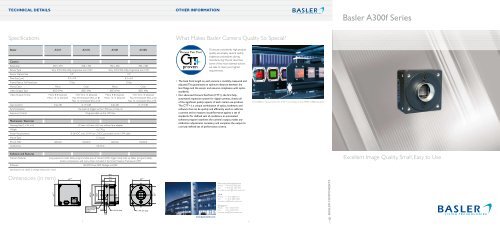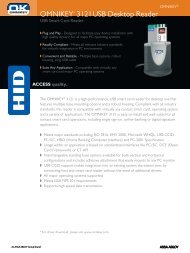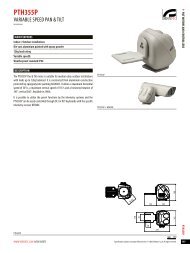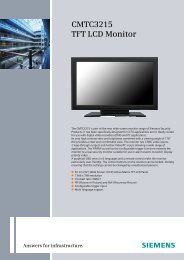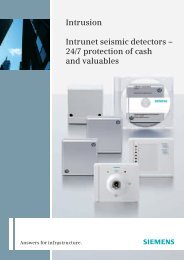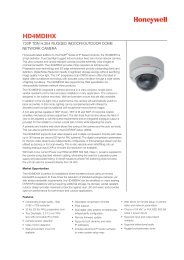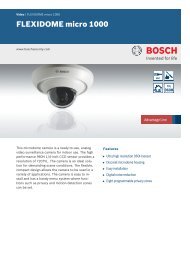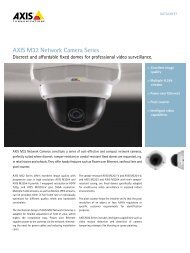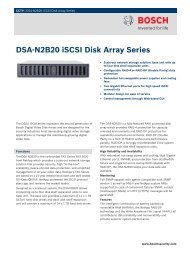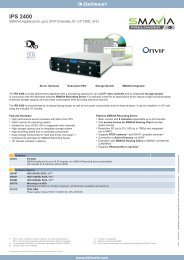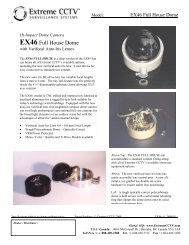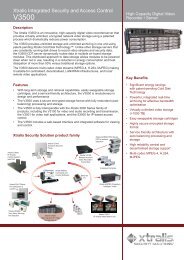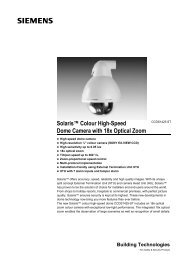Basler A300f Series
Basler A300f Series
Basler A300f Series
Create successful ePaper yourself
Turn your PDF publications into a flip-book with our unique Google optimized e-Paper software.
TECHNICAL DETAILS<br />
OTHER INFORMATION<br />
<strong>Basler</strong> <strong>A300f</strong> <strong>Series</strong><br />
Specifications<br />
What Makes <strong>Basler</strong> Camera Quality So Special?<br />
<strong>Basler</strong> A311f A311fc A312f A312fc<br />
Camera<br />
Resolution 659 x 494 658 x 492 782 x 582 780 x 580<br />
Sensor Type Sony ICX414AL/AQ, progressive scan CCD Sony ICX415AL/AQ, progressive scan CCD<br />
Sensor Optical Size 1/2” 1/2”<br />
Pixel Size (µm) 9.9 x 9.9 8.3 x 8.3<br />
Frame Rate at Full Resolution 73 fps 53 fps<br />
Mono/Color Mono Color Mono Color<br />
Video Output Type IEEE1394a IEEE1394a IEEE1394a IEEE1394a<br />
Video Output Format Mono 8: 8 bits/pixel YUV 4:2:2: 16 bits/pixel Mono 8: 8 bits/pixel YUV 4:2:2: 16 bits/pixel<br />
Mono 16: 12 bits/pixel Raw 8: 8 bits/pixel (R,G, or B) Mono 16: 12 bits/pixel Raw 8: 8 bits/pixel (R,G, or B)<br />
Raw 16: 12 bits/pixel (R,G, or B) Raw 16: 12 bits/pixel (R,G, or B)<br />
Gain Control 0-22 dB 0-17.4 dB 0-22 dB 0-17.4 dB<br />
Synchronization<br />
Exposure Control<br />
Mechanical / Electrical<br />
Housing Size (L x W x H)<br />
Weight<br />
Power Requirements<br />
Mount Type<br />
Via external trigger, via the 1394 bus, or free run<br />
Programmable via the 1394 bus<br />
42 mm x 62 mm x 62 mm without lens adapter<br />
ca. 210 g<br />
8-36 VDC, max. 3.0 W (at 12 VDC), provided via the 1394 cable<br />
C-mount<br />
IR-Cut-Filter optional standard optional standard<br />
Conformity<br />
CE, FCC<br />
To ensure consistently high product<br />
quality, we employ several quality<br />
inspection procedures during<br />
manufacturing. This list describes<br />
some of the most essential actions<br />
we take to meet your highest<br />
requirements.<br />
• The back focal length on each camera is carefully measured and<br />
adjusted. This guarantees an optimum distance between the<br />
lens flange and the sensor and ensures compliance with optics<br />
standards.<br />
• Our advanced Camera Test Tool (CTT+), the first fullyautomated<br />
inspection system for digital cameras, checks all<br />
of the significant quality aspects of each camera we produce.<br />
The CTT+ is a unique combination of optics, hardware, and<br />
software that can be quickly and efficiently used to calibrate<br />
a camera and to measure its performance against a set of<br />
standards. For defined sets of conditions, an automated<br />
software program examines the camera’s output, makes any<br />
calibration adjustments necessary, and compares the output to<br />
a strictly defined set of performance criteria.<br />
The <strong>A300f</strong> is measured by the CTT+ according to the EMVA 1288 standard<br />
Software and Features<br />
Camera Features<br />
Software<br />
Long exposure mode, freely programmable area of interest (AOI), trigger ready, look up tables (programmable),<br />
lossless compression, and many others included in the Smart Features Framework (SFF)<br />
BCAM Driver, SDK Package, and SFF<br />
Excellent Image Quality, Small, Easy to Use<br />
Specifications are subject to change without prior notice<br />
Dimensions (in mm)<br />
www.baslerweb.com<br />
Germany, Headquarters<br />
Phone +49 4102 463 500<br />
Fax +49 4102 463 599<br />
bc.sales.europe@baslerweb.com<br />
USA<br />
Phone +1 610 280 0171<br />
Fax +1 610 280 7608<br />
bc.sales.usa@baslerweb.com<br />
Singapore<br />
Phone +65 6425 0472<br />
Fax +65 6425 0473<br />
bc.sales.asia@baslerweb.com<br />
5 6<br />
12/08 3 BASLER COMPONENTS
THE <strong>A300f</strong> SERIES<br />
<strong>A300f</strong> <strong>Series</strong> – Excellent Image Quality at Standard Resolution<br />
<strong>Basler</strong> Camera Software<br />
How Does <strong>Basler</strong> Measure and Define Image Quality?<br />
The <strong>A300f</strong> series of digital area scan cameras is designed for<br />
industrial users who require excellent image quality at either VGA<br />
or CCIR resolution. A standard FireWire interface simplifies system<br />
integration and gives you increased flexibility when changing cameras.<br />
Your benefits from the <strong>Basler</strong> <strong>A300f</strong> <strong>Series</strong> include:<br />
∙ A small, rugged housing for easy integration<br />
∙ A plug and play FireWire interface combined with the<br />
easy-to-use <strong>Basler</strong> BCAM driver saves you time<br />
∙ Free download of our BCAM viewer<br />
∙ 100% quality checked and calibrated to give you consistent<br />
performance and reliability<br />
With their flexible design, <strong>A300f</strong> <strong>Series</strong> high-performance cameras<br />
are a perfect fit for a wide range of vision applications.<br />
High Framerate and CCD Image Quality<br />
The <strong>A300f</strong> series combines the high image quality of Sony progressive<br />
scan CCD sensors with fast frame readout. At VGA resolution the<br />
A311f /fc achieves up to 73 fps. <strong>Basler</strong>’s design makes this camera<br />
appropriate for applications such as semiconductor and component<br />
inspection, manufacturing quality control, food and beverage<br />
inspection, microscopy and medical imaging, and many others.<br />
The FireWire Advantage<br />
FireWire, also known as IEEE 1394, has become a standard image<br />
data and camera command transmission mechanism in the machine<br />
vision industry. Its key benefit is real-time communication between<br />
your camera and remote computer at 400 Mbit/s (with FireWire-a).<br />
FireWire integration is easy, cost-effective, and standardized. It<br />
supports plug-and-play and there is no need for a frame grabber.<br />
One Shot Operation and Software Trigger<br />
The camera lets you use the 1394 bus to “trigger” image capture<br />
without the need for a hardware generated signal.<br />
In “one shot” operating mode, the camera normally exposes and<br />
transmits a single image based on user defined parameters that are<br />
transmitted to the camera. This operating mode usually results in<br />
the start of image exposure within an acceptable amount of time.<br />
But to get an even quicker response, you can use a “software<br />
trigger” to start grabbing a single image exactly when it is needed by<br />
your application.<br />
Trigger Ready<br />
The Trigger Ready feature is a <strong>Basler</strong> patented innovation. It lets you<br />
optimize your image capture timing by monitoring the current<br />
camera settings and calculating the earliest moment each exposure<br />
can begin.<br />
By using the Trigger Ready signal, you can easily operate at the<br />
maximum frame rate allowed with the current camera settings. It<br />
also prevents you from running the camera faster than allowed and<br />
avoids dropping or losing images.<br />
Long Exposure Mode<br />
With <strong>A300f</strong> cameras, an exposure time of up to 5 seconds is<br />
possible. This lets you capture superb images even under low light<br />
conditions as is often the case in microscopy and medical imaging<br />
applications.<br />
12 Bit Image Digitization<br />
<strong>A300f</strong> cameras can digitize each pixel in a captured image at 12 bit<br />
depth. This lets you detect even the finest details. In addition, the<br />
camera’s remarkably low noise level provides an extraordinary<br />
signal-to-noise ratio. Images can be sent at 12 bits via the 1394 bus<br />
to a remote computer. You can use the camera’s look up table<br />
(LUT) feature to apply “lossless compression” to the image data,<br />
which helps you achieve the maximum possible frame rate.<br />
Color Coding and Preprocessing<br />
<strong>A300f</strong> color cameras feature various modes of color coding for<br />
maximum flexibility in color representation. YUV 4:2:2 color coding<br />
is done inside of the camera and YUV image data can be obtained<br />
directly via the 1394 bus. For individual processing, each pixel value<br />
can be read out separately in raw mode at 8 or 12 bit depth and<br />
can be processed as desired in your remote computer.<br />
BCAM Driver and SDK Package<br />
When combined with an <strong>A300f</strong> camera, the BCAM driver offers our<br />
users a robust, plug-and-play solution with exceptional performance.<br />
Integration is easy and problems with matching cables and creating<br />
interface files are eliminated. The driver has been extensively tested<br />
with a variety of 1394 interface boards to offer you a new level of<br />
reliability. The BCAM SDK package provides easy-to-use low level<br />
and high level C++ APIs on top of the driver. The APIs provide<br />
access to your camera’s full functionality (e.g., grabbing images and<br />
configuring the camera) with Visual Studio and Visual Studio.NET. In<br />
addition, the SDK package offers DirectX support via a DirectShow<br />
Video Source filter and includes DirectX source code samples for<br />
both Visual C++ and Visual Basic.<br />
Third Party Image Libraries and Software<br />
All <strong>Basler</strong> 1394 cameras are compliant with the 1394 Trade<br />
Association’s DCAM standard. DCAM defines standardized<br />
methods for exchanging data and commands between 1394<br />
cameras and computers. All image libraries and software packages<br />
compliant with DCAM will work with <strong>Basler</strong> 1394 cameras. The<br />
integration of an <strong>A300f</strong> camera with DCAM compliant software is<br />
as easy as can be.<br />
The SDK’s API is fully documented and comes with complete<br />
source code for the user mode driver. A collection of code samples<br />
demonstrates and explains how to use the SDK. The SDK package<br />
also includes some helpful tools (along with the source code for<br />
each tool) such as:<br />
∙ The BCAM Viewer - an integrated camera viewer program for<br />
grabbing images and for configuring the camera<br />
∙ The BCAM Topology Viewer (for Windows XP only) - a bus<br />
topology viewer program that lets you quickly evaluate the state<br />
of the 1394 bus and the availability of bus resources<br />
Smart Features Framework (SFF)<br />
When used with the BCAM Driver, the Smart Features Framework<br />
provides access to the smart features included on <strong>Basler</strong> IEEE 1394<br />
cameras. <strong>Basler</strong>’s smart features extend the standard IIDC feature<br />
set and offer capabilities like:<br />
∙ An Extended Data Stream that adds information about the<br />
current camera settings – such as shutter, AOI, offset, etc. –<br />
to the basic image data for each captured image<br />
∙ A CRC Checksum for the image data<br />
∙ A Frame Counter and Time Stamp for each captured image<br />
∙ Uploading of a Lookup Table to the camera<br />
∙ Lossless Compression of image data<br />
∙ Digital I/O Configuration<br />
A GUI called the “SFF Viewer/Configurator” is included with the<br />
Smart Features Framework. The GUI is used to configure your<br />
camera’s smart features and for grabbing images. The SFF also<br />
includes a C API along with some sample applications that explain<br />
and demonstrate the use of the API.<br />
A selection of companies offering third party products is shown<br />
below. Many other products are also available.<br />
∙ Cognex<br />
∙ Matrox Imaging<br />
∙ National Instruments<br />
∙ Stemmer<br />
∙ Euresys<br />
∙ MVTec<br />
∙ Neurocheck<br />
<strong>Basler</strong> Components is leading the<br />
effort to standardize image quality<br />
and sensitivity measurement for<br />
machine vision cameras and sensors.<br />
All measurements done by <strong>Basler</strong><br />
will be in 100% compliance with the<br />
new European Machine Vision Association EMVA 1288 standard.<br />
Because it describes a unified method to measure, compute, and<br />
present the specification parameters for cameras and image sensors<br />
used in machine vision applications, <strong>Basler</strong> is giving the EMVA 1288<br />
standard our strongest support. In the future, we will routinely<br />
provide compliant information about the quality and sensitivity of<br />
our products.<br />
The following charts and parameters are extracted from<br />
standardized quality and measurement processes used by the CTT+.<br />
Quantum Efficiency Sensitivity Parameters *<br />
Quantum Efficiency [%]<br />
60<br />
50<br />
40<br />
30<br />
20<br />
10<br />
0<br />
400 450 500 550 600 650 700 750 800 850 900 950 1000 1050 1100<br />
A312f<br />
A311f<br />
Wavelength [nm]<br />
Signal-to-Noise Ratio (dB) *<br />
Signal to Noise Ratio [dB]<br />
50<br />
40<br />
30<br />
20<br />
10<br />
0<br />
1 10 100 1000 10000 100000<br />
A312f<br />
A311f<br />
Photons per Pixel<br />
* All values are typical and are subject to change without prior notice<br />
Signal-to-Noise Ratio (bits) *<br />
Signal to Noise Ratio [bits]<br />
Sensitivity Parameters A311f A312f<br />
Quantum efficiency @ 545nm (%) 38 43<br />
Dark noise (e-) 23 23<br />
Saturation capacity (e-) 20000 21000<br />
Maximum signal-to-noise ratio<br />
(bits) 7.1 7.2<br />
(dB) 43.0 43.2<br />
Absolute sensitivity @ 545 nm<br />
(photons) 61 54<br />
Photo saturation capacity @ 545 nm<br />
(photons) 53000 49000<br />
Dynamic range<br />
(bit) 9.8 9.8<br />
(dB) 58.8 59.2<br />
8<br />
7<br />
6<br />
5<br />
4<br />
3<br />
2<br />
1<br />
0<br />
0 1 2 3 4 5 6 7 8 9 10 11 12 13 14 15 16 17 18<br />
A312f<br />
A311f<br />
Photons per Pixel [bits]<br />
2<br />
3 4


